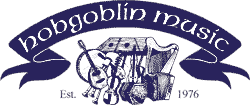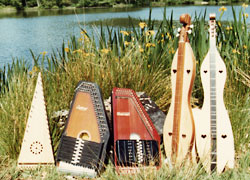
| THE HOBGOBLIN INFO SOURCE | |||
| HOBGOBLIN INDEX PAGE | HOBGOBLIN INFO INDEX | CATALOGUE CONTENTS | HARP ONLINE SALES | SECONDHAND PRICES |
| Harp FAQ | ||||
 |
ON THIS PAGE: Under Construction! Harp Origins Tuning the Harp Choosing a Harp Sharpening Levers Harp Makers RELATED PAGES: Care and Maintenance |
 | ||
|
© Copyright Hobgoblin Music 1983, 2000. This text may be freely distributed in whole or in part so long as the copyright holder is clearly acknowledged. Harp OriginsThe Celtic Harp is almost unchanged since the 11th century. Some mediaeval harps had a very slim body, but the famous Brian Boru harp has the same shape as the harps we sell today. Early harps had bodies carved from solid wood, and brass strings, and were diatonic, only playing in one key. Nowadays it is usual to use a softwood soundboard, and gut or Nylon strings, and to change key, the pitch of each string can be adjusted with semitone levers. The concert harp was developed from the Celtic Harp, or Clarsach, and features increased tension on the strings, a greater range of notes, and pedal mechanisms. Tuning the HarpHarps should be brought up to pitch gradually, in stages as the wood of the front needs to take up a slightly curved shape with the tension of the strings. First week tune up a tone and a half flat, then increase the tension a semitone at a time over the next week or so. Another useful tip when tuning is to first tune roughly to a diatonic scale, then get the Cs right, then go round in the circle of 5ths, first playing the Gs with the Cs, then the Ds with the Gs etc. Choosing a HarpThere are many factors which should influence your decision on what harp to buy, in particular range and transportability. A 22 string harp has a very similar range to a fiddle, and a much greater range than many instruments used in folk music, so it will allow you to play a vast number of tunes. The main limitation will be a lack of bass notes, so if you are particularly looking to play a bass accompaniment to your tunes you will definitely need a larger harp. The number of levers on your harp dictates the number of keys you can easily play in. Some celtic harps only have a few levers, or none at all, and this means that you will have to retune the strings to play in a different key. The levers allow you to introduce accidentals without retuning the harp. Larger harps give you a greater range and louder sound but on the down side they cost more and are more difficult to transport. A 22 string harp can easily be carried on your back like a ruck sack, but larger harps with 29 or 34 strings will need much more forward planning if you intend to travel with them. A Few Notes on Sharpening LeversWe use the Loveland brand levers made by Bob Bunker, because we believe them to be the best available for use on our harps. The sound is the most consistent and they deflect the strings the least of any that we have seen. We feel that the harp must be tuned and stable before the levers are put on, so that the intonation is accurate. For this reason, we do not premark the kits. We have instructions available for people who wish to install levers on one of our harps. The process is exacting and detailed but not overly difficult for someone who is careful and patient. The size (diameter) of the strings varies from .025 inch to about .1 inch on our harps. The sharping levers are manufactured to each fit only a certain size of string. There is an identifying number embossed on each lever. The string chart that comes with each harp lists the size of each string and the correct sharping lever to install on that string. The following is a chart of the sharp and flat keys and the correct string on which to install a lever in order to get each one. Remember that a three octave harp, for example, will have three F strings and require a separate lever on each one.
Harp MakersStoneyend HarpsStoney End harps are made in the USA. They are all strikingly good looking and have a really lively and bright response, which is maintained all the way to the top end. Stoney End make lap harps and floor harps in a variety of styles. All of the Stoney End harps that are imported into the UK (apart from the Wee Bonnie model) are fully levered with American made Loveland levers, but the harps can be ordered to any specification. On the larger Stoney End harps, the strings are spaced as on a full sized concert harp. The lap harps have slightly closer spacing. Solid Walnut or Cherry wood is used for the structural frame and pinblock. The plywood side and back panels are inserted into dado cuts in the solid corners and the base. This makes a durable and strong, yet very lightweight harp body. The unusual soundboard is at the heart of the Stoney End sound. A Baltic Birch laminate is used, which provides exceptional strength with low weight and makes it possible to have cutouts on both the bottom and top ends of the string band. This opens up the soundboard and makes it free to vibrate over its entire surface, something that thicker, stiffer, more confined soundboards cannot do. Stoney End harps are often praised for offering the best combination of a great sound and affordable price. They are very reliably made, and always look and sound fantastic. The workshop where the harps are built is based in a huge barn in Red Wing, Minnesota, which also acts as a showroom and shop. Visitors to the workshop and showroom are invited to watch the harp building process through viewing windows. Stoneyend harps are readily available in the UK. The most popular models (the Eve, Anne, Lorraine and Wee Bonnie) are stocked at Hobgoblin Music shops across the country, and all Stoneyend harps and harp kits are available to order. Back to the Top of the Page |

